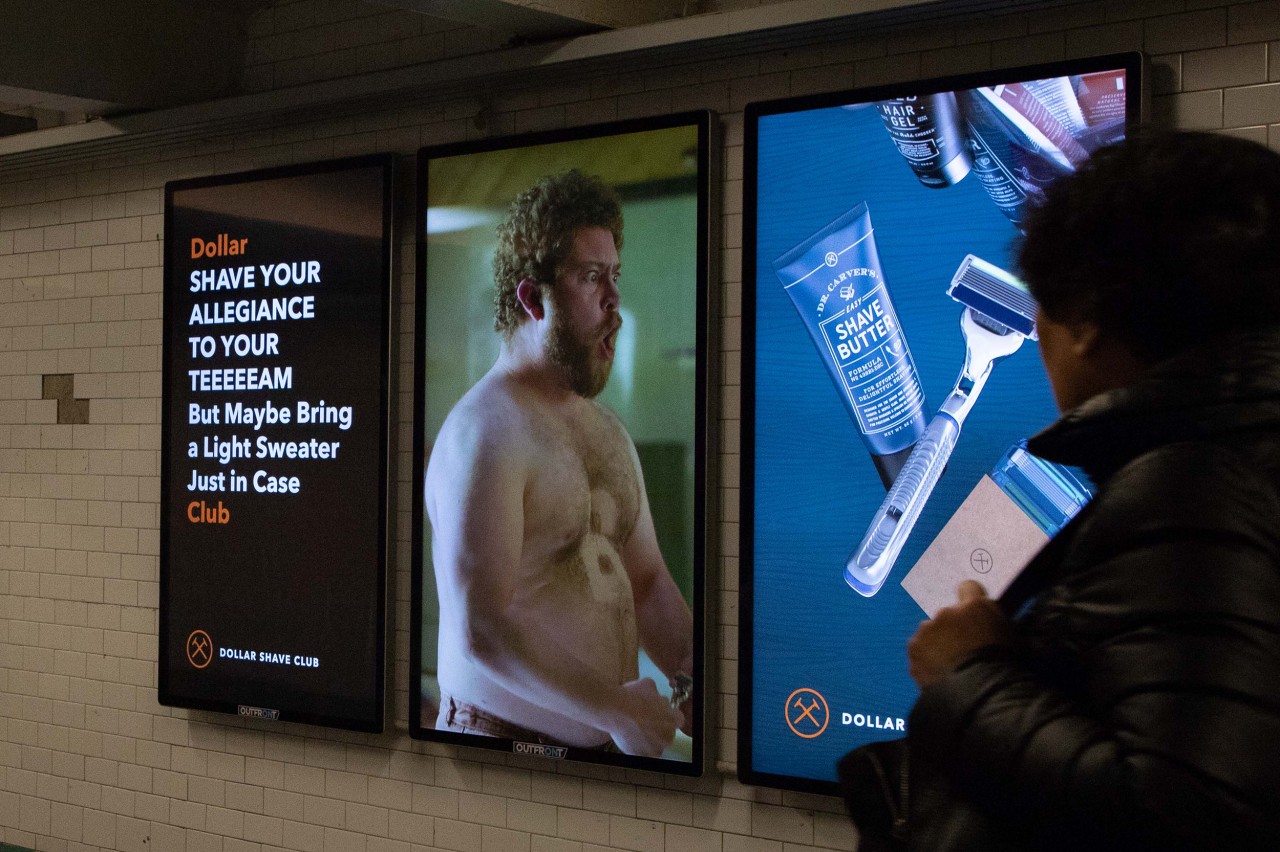NOW TO NEXT: News You Will Use
Chapter 1: Why Bother?
Chapter 2: KNC Web3 Strategic Growth Opportunity Area Framework
Chapter 3: A Short Sharp History
Chapter 4: The Metaverse: Reports of its Death Have Been Greatly Exaggerated
Chapter 5: And Finally, to the Topic of AI
Chapter 6: Where are You in the Journey?
THE BRAND WHISPERER’S GUIDE TO THE FUTUREVERSE
Getting Past the Hype, Out of the Weeds and Into the Light
Kate Newlin Consulting (KNC) is a business strategy consulting firm, working IRL, VR and most profoundly in the emerging technology space which rapidly collapses the distinction between these two very real realities. During the past year we have seen the future and realized it is now. A once in a career step-change is underway, offering a radical reimaging of business pain points: Web3. That the digital reformation is upon us is undeniable. These important and urgent questions will impact how strategically and quickly professionals respond.
EXECUTIVE SUMMARY
When covering holiday gift-giving last December, The Wall Street Journal reported that “Kids Don’t Want Cash Anymore – They Want ‘Robux.’” This March, San Francisco-based couple, Sheel Mohnot and Amurta Godbole, won a contest to have their wedding sponsored by Taco Bell, hosted entirely in the Decentraland virtual gaming platform. This, following Beeple’s 69 million dollar sale of his NFT graphic design collage, “Everydays,” at Christie’s in March of 2021, and IBM’s recent re-introduction of Watson X to facilitate AI within a business setting.
The conversation about the virtual and physical circularity for brands and consumers is both deafening and confusing. In the same way we witnessed the emergence of the internet, and subsequent evolution of social media, we now see the birth of tools and technologies putting audience and influencer within each other’s reach. A vast step change auguring co-creation and community engagement beckons.
How do we impact, lead and capitalize on this evolution ratcheting up to revolution?
This issue of NOW TO NEXT: News You Will Use has three core objectives:
1. To provide a strategic framework through which to envision Web3 landscape opportunity areas
2. To identify key salient use case examples
3. To define key terms and concepts and all those pesky acronyms
Simply put, if you wonder at Web3’s relevance and business impact for brands and business, read Chapter 1: It’s time to bother. In Chapter 2: KNC identifies five key areas in which Web3 initiatives demonstrate proven value. Here we provide real-life examples of digital-leading businesses and institutions using emerging technologies to solve entrenched problems and address stubborn pain points. Chapter 3 provides a short, sharp history of how we find ourselves in the midst of a Web3-inspired systems change: We believe it is a once-in a career opportunity. This provides a quick overview of Web3 advance over its predecessors, Web1 and Web2. Chapter 4 highlights compelling use cases from innovative companies and organizations in a variety of sectors and around the globe. Think BMW, Lowes, Accenture and Cedars-Sinai’s Health Service. AI and its more advanced iteration, GenAI, is covered in Chapter 5. When you get past the hype and hoopla, there is immense value to the technology already being used to great benefit. Chapter 6 challenges the reader to reflect on the potential business applications of emerging technologies.
KNC’s view is that if you aren’t already engaged, you are already behind. We are ready – map in hand – to sherpa your exploration of the FutureVerse.
Chapter 1: WHY BOTHER?
The daily coverage of innovations across emerging technologies brings with it a cacophony of opinions and pronouncements, typically in direct opposition to each other. What is clear is that there is a march of rapid evolution transforming how we live: in ways both known and unknown, both predictable and unpredictable. The closest parallels reside in history books: The invention of the printing press or the steam engine.
It is tempting in this time of great systems change to stand on the sidelines and observe, waiting for the moment when the new normal emerges, when risk is diminished, reward is sure. But we know that business success is not a spectator sport.
Another temptation is to scoff: “That’s just for kids – for the gamers.”
As Diego Borgo, NFT and Metaverse advisor notes, “One of the biggest mistakes or pitfalls that brands have fallen into (is to believe Web3) is only talking to the Web3 native. That’s a demographic that you could literally fit inside of a building…But what they should be doing is leveraging Web3 to their already existing audience in a manner that solves existing business problems or taps into opportunities.”[1]
If we are to learn nothing from post-pandemic rise of enhanced connectivity through technology, let us take away the understanding that innovation will continue to move at a lightning speed, regardless of if we prefer, support or even initially engage with it. There is no more connected population than the GenZ -ers and GenAlphas who are the consumers of today and tomorrow. In order to keep current, and attempt to stay ahead of their anticipated needs, desires and mechanisms of engaging with a brand, we must at least endeavor towards defining how we do this. At the precipice of this conversation is brand and thought leaders. Those who ushered in the capstone moments of the organizations they now lead, and who are ambassadoring the next wave of tomorrow.
What this means is laboring to at very least be cognizant of the advancements that have been made within the ever-evolving Web3 space, that include digital and virtual elements which can take you one step closer to your target audience. They involve the enhanced creativity found in expanding outside of a 2D ecosystem, towards building 3D worlds that inspire the thinking outside of a physical paradigm, of a shop with walls, and designing with endless possibilities. They also empower thought leaders and brands to harness their expertise to fuel a workforce that is augmented by efficiencies in artificial intelligence to push forward campaigns, products and global footprints, while ensuring the mission, style and integrity of the foundation of your organization is closely adhered to during this growth.
Said another way? McKinsey estimates by 2033 we’ll be looking at a $5 trillion Web3 ecosystem. Trillion with a T.
Chapter 2: KNC WEB3 STRATEGIC GROWTH OPPORTUNITY AREA FRAMEWORK
To this pursuit, KNC identified five key areas in which Web3 initiatives have demonstrated proven value:
1. Branding and Marketing: Here’s where brand building opportunities reside, including: “down-aging” the brand, building and enhancing the impact of brand community, expanding brand loyalty, insulating the brand and business from competition, margin growth and finally, customer journey expansion.
2. Revenue Creation and Protection: New digital only or digital-first products, circularity between IRL (In Real Life) and VR (Virtual Reality) purchases, avatar engagement.
3. Recruitment and Training: The U.S. Department of Defense is gamifying all sorts of training and recruitment processes. Imagine the benefits for QSR and fast casual dining, customer-facing retail and new employee on-boarding.
4. Operational Efficiencies: Perhaps you’ve got a global brand with 24/7 customer service required everywhere you do business. Or you need to make (and ensure functionality of) design improvements from Milan to the manufacturing facility in Vietnam. Or you need to reduce ecommerce returns.
5. Footprint Expansion. Web3 tactics do not share the same country and geographic boundaries as the IRL globe. Here you can foreshadow your brand, create awareness and understanding, even provide VR avatar brand experience before opening a single brick-and-mortar shop in a new country. An often-overlooked opportunity is the real estate implications, particularly for franchise-model businesses: this is a whole new map, actually several new maps. What if in 10 years your virtual franchisee revenue could exceed today’s IRL income? What might you do differently today?
Our framework employs this matrix to spark, develop and evaluate the tactical application of Web3 tools.
KNC Technology Value Creation Scorecard
Pain Point Purpose
Metaverse
Gaming
XR
NFT/Blockch
ain
AI
Brand Marketing
Ralph Lauren
Wendy’s
Gucci
Adidas
L’Oréal
Revenue Generation
LVMH
Claire’s
Accessories
IKEA
Nike
K Health
Recruitment & Training
Marriott
Accenture
Operational Efficiencies
BMW
Lowe’s
DeBeers Group
Cedars-Sinai
Footprint Expansion
Hugo Boss
Allstate
Thee real-world examples are modeled after digitally led organizations using new solutions to solve entrenched problems and address stubborn pain points. Along the way, we will define important terms and concepts, under the assumption that you didn’t join your kid’s coding camp and you don’t self-identify as a computer programmer. Chapter 3: A SHORT SHARP HISTORY
Let’s step back a bit and provide the emerging context in which artificial intelligence (AI) and other technologies fit together in the evolving digital landscape. Start with understanding the principles and concepts behind “Web3.”
Simply put, as Professor Madhukant Sharma[2] writes, “Web1 was all about fetching and reading information. Web2 is all about reading, writing, creating and interacting with the end user…Web3 is the third generation of the World Wide Web, and is a vision of a decentralized web which is currently a work in progress. It is all about reading, writing and owning.”
In 2000, it was unthinkable to imagine that today ecommerce’s share of global retail sales would top an estimated 20+percent, with transactions on mobile screens growing faster than those on computers.[3] Or to predict how ecommerce would fundamentally transform retail and the consumer goods and services purchasing patterns.
Technological advances and a drive to modify and engage with the constantly evolving internet led us to the era of Web2, often called the participatory social web. Communication flowed between the content creator and the user. Interactive communities like My Space (2003) and Facebook and Twitter X (2006) sprang up, allowing a new level of interactivity and exchange for users. In 2000, “smartphones,” which have existed in the mainstream since 1994, were connected to 3G networks. In 2007, Apple’s first iPhone provided the first full smart phone access to the internet, unleashing a furious telecom arms race to connect consumers across devices and claim market share. So long, Blackberry.
Web2 brought the advent of podcasts, blogs, and social media, along with an increased desire for the distribution of content to be shared, engaged and seen on the internet.
Fast forward to the birth of Web3.
Ethereum[4] co-founder Gavin Wood coined the term Web3[5] in 2014, but it was not until about 2021 that its general concepts broke into the non-geek world, largely from hype generated from crypto-currency start-ups, large tech companies and venture capital firms. Web3 is also called the “Semantic Web” or “the decentralized Web.” In a nutshell, Web3 represents the future of the internet, and links a variety of tools and technological data across webpages, applications and files packaged in a variety of formats.
What Web3 is today -- and what some think it will become -- is evolving. And just like the onset of Web1, when we connected our computers to a noisy dial-up phone line, no one can be sure how the digital landscape will mature.
Journalist Robert Stevens explains what differentiates Web3 from its predecessors in an article published on Coindesk.com6:
“Web3 promotes decentralization and individual user empowerment, reducing reliance on tech behemoths such as YouTube, Netflix, and Amazon”…It “allows individuals to have more control over their data and content, moving away from the "walled gardens" created by large tech companies…Cryptocurrencies (Crypto) serve as the native payment system in Web3, enabling decentralized peer-to-peer transactions. Non-Fungible Tokens (NFTs) offer a way to establish ownership and trade unique digital assets, aligning with Web3's focus on user control and decentralization.”
Web3 and Metaverse Advisor, Diego Borgo, describes Blockchain as the “backbone” of Web3. A blockchain is a database of transactions that is updated and shared across computers in a network. Every new transaction, or “block,” is connected to an asset, and added to the transaction before it. It can’t ever be removed – thus creating a blockchain – and is traceable and transparent to relevant parties.
The first time most regular folks heard about blockchain was probably in connection with the 2022 burst bubble of speculative cryptocurrency trading amidst a flurry of criminal charges, following on the heels of the collapsed frenzy to sell and trade digital art, executed as NFTs.
Digital art is built on the idealistic notion that selling art as NFTs enables artists to be more fairly compensated as their work accrues value through resale. In theory, the artist receives additional revenue as their work resells at a higher value because the transaction is traceable. It is an intriguing idea that so far really hasn’t scaled beyond a trendy few despite frothy headlines a few years back[6]– partly because most people who collect art want to be able to display it in real life. And, partly because as one fine artist we know told us, “I just haven’t seen anything in the digital art world that is very interesting or beautiful.”
In hindsight, the dramatic 2022 collapse of crypto currency values can be seen as an inevitable market correction, reigning in irrational exuberance and in some cases, profiteers.
But, as Andrea O’Sullivan wrote for the James Madison Institute, “Yes, there was a lot of stupidity and a lot of scamming going on…But there was real innovation that got kind of ignored amidst the gold rush.”[7]
The opportunity for blockchain to interact with conventional commerce, art and culture was largely overlooked.
We won’t go down the rabbit hole of the collapse of crypto currency here. But a quick primer can be found from NPR, https://www.npr.org/2022/12/29/1145297807/cryptocrash-ftx-cryptocurrency-bitcoin, should the reader like to dig deeper.
Now that this century’s Dutch Tulip Mania bubbles have burst on crypto trading and digital artwork, businesses and organizations around the world are taking a serious look at how the technology and concepts underpinning Web3 may create real value for them.
In this decade, groundbreakers across the digital and physical sectors are using NFTs to build brand awareness and engage, reward and retain customers, and to create nontraditional streams of revenue creation.
Early adopters here include leading brands in luxury and fashion (Fendi, Hublot, Prada, Rimowa, Givenchy – just a few of those following on Gucci’s groundbreaking heels) -- athletic footwear (Nike and adidas) brands and category leaders like Coca-Cola. In recent months, brands as varied as Louis Vuitton and 7-Eleven are finding ways to jump between virtual and IRL, employ crypto currencies and activate new partnerships to engage customers and fans.
Innovators across a vareity of industries are also finding a variety of uses cases for blockchain, which besides providing transparent ownership and financial transactions, can also be used to validate supply chain traceability.
One example here is DeBeers Group, which is using blockchain technology to verify the end-to-end ethics of its diamond supply chain. Leading luxury conglomerates LVMH, Prada, OTB and Richmont, normally competitors, formed the Aura Blockchain Consortium in 2021. The Consortium promotes the use of a single blockchain solution, available to its members, in which RFID tags (Radio Frequency Identification) or NFC (Near Field Communication) offer traceability and authentication of its high value merchandise. The pain point the Consortium is trying to solve is the high rate of theft and counterfeit goods each of these companies combat.
Another use case within the consumer goods sector follows companies who are exploring blockchain technology to authenticate a variety of elements, including the veracity of ESG claims.
As a recent White Paper published by the Beijing Municipal Science & Technology Commissioned stated, Web3 is an “inevitable trend for future internet industry development.”
Inevitable. KNC agrees.
Chapter 4: THE METAVERSE: REPORTS OF ITS DEATH HAVE BEEN GREATLY EXAGGERATED
And now to the Metaverse. The Metaverse isn’t dead. But it is definitely a term that has gone out of favor. If you are familiar with the Gartner Hype Cycle,[8] a non-scientific graphic representation of the maturity, adoption and social application of certain technologies, the Metaverse has evolved from the “peak of inflated expectations” and the “trough of disillusionment” to where we sit now, simmering in the slope of “enlightenment” – which leads to true productivity.
Even some of the most astute tech observers conflate the terms Web3 and Metaverse. They aren’t the same, but they are related.
According to McKinsey & Company, the Metaverse is “the emerging 3D-enabled digital space that uses virtual reality, augmented reality and other advanced internet and semiconductor technology that allow people to have lifelike personal and business experiences online.”
Stay with us, now. McKinsey also said, “Some believe it’s a digital playground for friends. Others think it has the potential to be a commercial space for companies and customers.[9] KNC agrees with McKinsey that it has the capacity to be both.
And the potential is vast.
At its basic level, the Metaverse includes a sense of immersion, real-life interactivity, and user agency. The suite of current technology with it includes Augmented Reality (AR), Mixed Reality (MR),Virtual Reality (VR), Generative AI, the use of cryptocurrency, spatial computing (technology that enables computers to blend in with the physical world in a natural way)[10] and more.
Collectively, AR, MR and VR are sometimes referred to as Extended Reality, or XR.
In AR, digital content is overlayed onto the real world, through some device, like a smart phone or smart glasses. An early study of cognitive function in humans suggests that AR experiences deliver almost double the level of engagement compared to non-AR equivalents like TV watching or general online browsing.[11] Think of the potential for training and teaching with AR within that context!
IKEA, Crate and Barrel, Wayfair and Houzz are just a few home decorating brands and retailers using AR apps to allow a user to visualize merchandise as if it were actually in their homes before they buy it. Brands have been using these “try before you buy” tools for about six years. As the technology becomes more user-friendly and robust, consumers are going to expect these tools from furniture and home decorating resources.
Other sectors aggressively innovating with XR include Beauty, Jewelry and Optical. “Try” on your glasses, hair color, foundation, wrinkle cream, eyeshadow, lip color or even diamond ring before you make your purchase. Reduced return rates and cart abandonment are measurable benefits of AR technology for online merchants.
VR is more immersive than AR, using 3D digital images and videos to convey a real or imaginary world, with sound and light. Today, users of VR access and control these environments through a combination of devices, headsets and controllers. Meta’s Oculus is by far the favorite VR headset today. Apple, in its first new product category launch since the 2015 Watch, will roll out its own headset, the Apple Vision Pro, in early 2024. Prices will start at an eyepopping $3,499 per pair.
KNC has no crystal ball, but don’t be surprised if once the chattering classes settle down on AI, XR is the next hot topic. Its potential to transform business operations and customer relationships is virtually…limitless. Let’s look at some of the compelling use cases across sectors.
Gaming: The New Marketeer’s Playground
The earliest and largest group of VR users play online games. At least since early 2000 gamers have been able to navigate inside 3D gaming environments in real time, often acting with many other players. Their IRL persona inhabits the virtual game as a personalized virtual representation; these are called avatars.
Back in the Web2 era, Lego, the iconic toy brand, used gaming as the cornerstone of a turnaround plan in 2005. It partnered with Lucasfilm to introduce a video game featuring Lego figures and bricks transformed into Star Wars characters. In 2023, gaming remains an important piece of Lego’s strategy for marketing, branding and revenue, contributing to nine consecutive years as the world’s most valuable toy brand.[12]
Today, global gaming, which also includes “experiences” that aren’t, strictly speaking, “games,” is valued at between $180 billion and $200 billion. There are more than three billion estimated active users globally. The spend is bigger than the movie and music industry combined. About half the revenue comes nearly equally from the United States and China.
Newzoo, a market analysis firm, forecasts that the gaming market will grow to more than $206 billion in 2025.[13]
Leading gaming platforms and e-games include Roblox, Minecraft, Epic Game’s Fortnite, Animal Crossing, The Sims, The Sandbox, and Decentraland. Each has its own personality, rules, pay systems and demographic. Web3 versions of these immersive virtual worlds include NFTs and blockchain, but plenty of Web2 versions continue.
In a May earnings call, Electronic Arts (best known games are “FIFA” and “The Sims,”) CEO Andrew P. Wilson stated, “Games are the social networks of the future.”
Savvy marketers to consumers are seizing upon the powerful social network the gaming world represents as a new way to engage with consumers in a deep, more direct and more immediate medium. The space is very much evolving, with experimentation in brand building, brand repositioning, brand down-aging and brand awareness leading use cases. In some cases, brands are participating in “one-off” and limited time activations. Those who’ve tested and learned in the last few years are investing in creating their own branded virtual worlds or deepening engagement in the channels through creative collaborations and special events.
Users skew young: nearly half are 12 years-old or younger, with the fastest growing demographic in the 17 – 24-year-old bracket (21 percent); users 25 and older at 17 percent and teens 13 – 16 at 15 percent of share. [14] Perhaps surprisingly, 44 percent of users are female versus 51 percent reporting as male.
Roblox is the top gaming platform today. It rolled out in 2006. Roblox allows players to build their own virtual worlds and also to play a broad range of user-created games. Roblox reports more than 66 million daily active users and 214 million monthly active users. Its largest cohort of daily users is in Europe, followed by North America and then Asia Pacific.
Players can be found in 181 countries. Nearly three-quarters of daily users on Roblox engage on their mobile device, but there are desktop and console options as well.
One of the amazing features of Roblox is the level of engagement its daily users spend on the platform: an average of 2.6 hours. That beats engagement on TikTok and Instagram by leaps and bounds.
Just a few consumer brands with activations on Roblox are Forever 21, Gucci, Nike, Victoria’s Secret, Tommy Hilfiger, Van’s, Walmart, H&M, Alo Yoga and Gap. Beauty brands have been especially active on Roblox; Gucci Beauty, Urban Decay, NARS, Givenchy Beauty, Nyx Professional Makeup, Essence Cosmetics and Fenty Beauty have all launched virtual worlds.
Fenty Beauty’s July activation illustrates the collaborative and creative possibilities that abound. The 30-day-long virtual world featured interactive scavenger hunts, mazes, and creation opportunities. The virtual experience features key IRL products from the Fenty product line and allows users to create their own virtual Fenty Beauty Gloss Bomb Universal Lip Luminizer, a signature IRL product. Repeat user participation is incentivized by weekly accessory drops for avatars to wear.
Among other activities, users could customize a virtual product inside the game and share their “creation” with Sephora, an important third-party retailer of the brand and collaborator within Roblox. Through a series of weekly votes, 400 finalists were nominated by visitors to the Sephora Experience virtual retail display. Rihanna is said to be selecting the winning creation, which will serve as inspiration for the next Gloss Bomb and made into
a real-life product that will be sold later this year through FentyBeauty.com and Sephora.com.
This activation ticks three boxes: Innovative Brand Building and Marketing, Revenue Creation and Footprint Expansion on the KNC Value Creation Impact Matrix.
Other major brand owners experimenting with metaverse technology include Maybelline, Tiffany & Co., Bloomingdale’s, Coach, Dolce & Gabbana, Ralph Lauren, Tommy Hilfiger and Gucci, a truly cutting-edge player in this space.
It is only logical that brands that appeal to younger consumers are exploring how they can engage their consumers and longer term, monetize the gaming channel.
Hurley, the California-based surf brand, announced that it will introduce the Hurley Super Surge game in time for back-to-school. What’s distinctive in this instance is that Hurley will not be dropping the game inside an existing platform like Roblox or Decentraland. Players will download the free game directly on Google Play or the App Store. The activation is meant to merge the brand’s surf DNA with physical and digital merchandise sales. It is an immersive game that enables multiplayers to engage virtually with avatars of legendary IRL surfers, dodge mythical sea monsters and collect Hurley Sand Dollars (aka NFTs).
Assuming the game is fun, engaging and technically operative, the success of this DIY strategy will depend to a great extent on the brand owner’s ability to drive customers to the app and to keep them returning to it.
New ownership at Claire’s Accessories following its 2018 bankruptcy seized upon emerging digital technology as the cornerstone of its strategy to re-imagine and rebuild the brand. The mass market vertical jewelry and accessories specialist launched “Shimmerville,” in November, 2022 on Roblox, with players earning NFTs and
accessorizing their avatars. Claire’s is registering millions of users and collecting valuable and actionable data about them through the activation. They have also linked their existing loyalty program to the game, so a Claire’s customer is rewarded IRL and XR, wherever she makes a purchase.
Claire’s management has made it known that they intend for ShimmerVille to eventually become a direct revenue stream for the company. Progressing the digital connection to the physical, this summer, Claire’s launched a collection of IRL plush toys in its brick-andmortar stores based on the popular virtual pets users collect in ShimmerVille.
Kristen Patrick, the company’s EVP and CMO commented, “We see gaming and what we’ve done with ShimmerVille as a long-term franchise for us as a company. We really are managing this much like a movie studio would.”
No surprise: Barbie has a dream house in beta testing with Roblox, in anticipation of a full game release. Mattel’s launched a beta test in July of “Barbie™ Dreamhouse Tycoon” to coincide with the Barbie movie’s global release. Despite a nominal paywall, more than a million players sampled in the first week, averaging an above-average playtime of 13 minutes.
Creation, Collaboration and Community in the Fashion and Luxury World
As brand owners and marketers become more comfortable in the Metaverse, new applications of the technologies are reaching well beyond “play” and recreation. Louis Vuitton Moёt Hennessy (LVMH) recently announced it would partner with Fortnite’s parent, Epic Games, to use their 3D technology to create virtual fitting rooms, digital fashion shows, 360-degree product carousels and interactive advertising.
Toni Belloni, LVMH Group MD said in a statement, “We have always been committed to innovations with the potential to bring our customers new experiences. Interactive games, which have developed into a full-fledged cultural phenomenon, are a perfect example. We will also engage more effectively with young generations who are very much at ease with these codes and uses.”
Fortnite’s first luxury brand collaboration was a Balenciaga virtual “store” within its
“Strange Times” game, building on Balenciaga’s own video game, “Afterworld.” The
Fortnite activations included offering digital and in-real-life apparel for limited time purchases. The collaboration was widely promoted across media channels, including 3D billboards in London, New York, Tokyo and Seoul in real life, and billboards in the virtual world as well throughout September, 2021. Perhaps not coincidentally, that year, LYST Index’s third quarter “world’s hottest brand” was Balenciaga.
While attendance for the second annual Metaverse Fashion Week in Decentraland last April was disappointing, a number of leading global brands offered up an array of immersive activations that suggest that the fashion industry, one of the earliest adopting sectors, has matured from creating one-and-done activations to generate publicity, to robust projects that clearly have strategy behind them and were supported and augmented by consistent messaging across multiple marketing channels and mediums.
Among just a few of the brands going immersive at Fashion Week were adidas Originals, Hugo Boss, Coach, Tommy Hilfiger, Nike, Aeropostale and Clinique.
Reporter Nicole Silberstein highlighted the Coach Decentraland activation, which was inspired by its iconic in-real-life “Tabby” purse, and included avatars of artists creating content, daily chances for participants to win digital wearables and a virtual dance party. The whole Decentraland experience linked up to Coach’s social media and advertising, featuring a collaboration with pop star Lil Nas X.
As Silberstein opines in Retailtouchpoints.com, “Linking the Decentraland experience to the marketing campaign’s theme highlights the potential of metaverse experiences to build brand loyalty and consumer engagement in larger brand activations. Not to mention the fact that the centerpiece of Coach’s Decentraland experience was a real bag that can be purchased IRL.”
KNC expects immersive experiences will continue to be embraced by brands and marketers because they line up with universally changing patterns in media consumption and communication technologies, particularly among digitally native Gen Z and Gen Alpha around the world.
Engaging Young Consumers Where They Live
Seizing the opportunity to “down-age” its brands and engage a new cohort, Campbell Soup
Company’s first NFT was a redesign of its soup label. Last January, Campbell's Chunky Soups introduced “The Chunky FuelUp Tournament” on Fortnite, leveraging its official NFL sponsorship. The branded experience featured football-themed games, with players competing for NFL prizes in a live-streamed finale. A couple of months later, the company raised its full year financial guidance. Coincidence? Maybe.
The Wendy’s Company transformed its stylized, red-haired, pig-tailed brand likeness of founder Dave Thomas’s daughter into an avatar in “Wendyverse.” Virtual Wendy is a sassy action hero engaging in food fights, while real life Wendy is well-qualified for an AARP card.
Similarly, State Farm Insurance is betting big on the Metaverse. Last September, it launched the first of twenty one-of-a-kind fan experiences in Fortnite, with IRL pop star Charlie Puth taking the virtual stage[15], in a pre-recorded 2D concert that his fans attended as 3D avatars. Linking the virtual world with real life, Puth’s appearance anticipated the launch of his latest album. An XR album release party screened in iHeartLand the following month.
Presumably, State Farm hopes to raise brand awareness and loyalty to first time licensed drivers and eventual renters and homeowners through this year-long activation. In an interview prior to the Puth event, State Farm executives told The Hollywood Reporter (THR) its collaboration on iHeartLand was a test for future iterations on this and other worldbuilding game platforms.
Experiences in iHeartland are intended to remain free for users, with the company behind it, iHeartMedia, expecting to monetize the virtual world through sponsorship deals and third-party advertising, according to THR.
Both partners are professing flexibility as they navigate an emerging channel, with Gayle Troberman, iHeartMedia’s CMO telling THR, “iHeartland and State Farm Park may evolve differently and dramatically” based on what players “love and what they love less.”[16]
Music in the Metaverse and specifically, in the gaming world just makes sense when you think about its demographic and universality. KNC expects to see more and more of it as technology develops and marketers figure out how to effectively navigate this new virtual world. Ariana Grande and Travis Scott have also “performed” in Fortnite, but in those instances, both fans and musicians were avatars. Even so, Grande’s performance was attended by about forty million visitors and players, at one time. How many world tours would she have to do to reach that same number of fans?
What drives these brands to these platforms?
• Brand awareness and brand building – often among younger consumers that may otherwise be unlikely to learn about it (Gucci Garden in 2021, launched on Roblox, is among the earliest activations by a luxury brand on a gaming platform.) Classic footwear brand Vans has seen more than ninety million visits and a 91 percent positive user rating for its Roblox activation.
• Brand loyalty and engagement o through collaboration and creativity in the player community, in which active and real-time connection creates itself organically. Gaming platforms are emerging as hosts to loyalty programs (McDonalds Hong Kong launched
“McNuggets Land” in The Sandbox platform this year to celebrate
McNuggets’ 40-year anniversary.) o Leveraging UGC (User Generated Content.) Core to immersive gaming platforms is the collaboration and contributions posted by the user community. Savvy brands are finding new ways to leverage UGC across all communication media channels. Think of it as the next generation thirdparty attribution versus paid media.
• Brand expansion – the brand can be accessed at any time of day or night, wherever a player has online access, through multiple devices
• “Phygital” monetization, where players are directed and motivated to make IRL purchases on the platform or through links or QR codes
• Monetization within a digital channel -- The most obvious example is where a player pays for a digital product that can be used in the virtual world.
As Futurist Leah Zaidi notes in a recent LinkedIn post, “If you show people real use cases of Metaverse tech without using the world ‘Metaverse,’ they want it…Understanding it requires the ability to spot signals from noise (90 percent of it is noise), and think of in long arcs, and imagine alternatives.”[17]
About Those Troublesome NFTs…
Zaidi’s comments are a good segue to return to the evolving use cases for NFT’s, which are being called many other names to dissociate from earlier negative connotations. Brand owners and retailers are increasingly experimenting with digital Tokens (The “T” in NFT) in several interesting ways, such as the following:
• To engage and reward users (customers, employees, fans) for participating in their brand
• As virtual “products” that can be bought for use in the digital world -- perhaps a comely hat for their avatar, for example
• To enhance established loyalty programs or create new ones
• To create phygital interfaces, where, for example, a customer’s virtual world is somehow linked to a real-life brick-and-mortar store or e-comm channel
Gucci collaborated virtually with creators (really, its brand fans,) to develop digital footwear, which ultimately were sold digitally as an NFT but also IRL, one of the first socalled “phygital” (Digital + Physical) brand activations in the luxury space.
You can expect the recently announced collaboration of footwear giant Croc with Doodles, an NFT creator to bring mainstream attention to the NFT space. With musician and style icon, Pharrell Williams as Chief Brand Officer and Croc’s Jibbitz quirky collectibles, the brand is a natural for the Metaverse.
Once you start looking, you’ll find the Metaverse embedding in everyday life: Starbucks, for example, made headlines last December when it opened a new membership program called Starbucks Odyssey. Odyssey offered new benefits and promises “immersive coffee experiences that (customers) cannot get anywhere else;” members make purchases, complete games and quizzes for rewards.
A few months later, Starbucks took the next logical step and launched a limited edition of 2,000 pay-for NFTs, (which they call “stamps” in a bid at user-friendliness) priced initially at $200. CoinDesk reports the stamps sold out within 20 minutes. While $400,000 is a drop in the proverbial latte to Starbucks, this project tests a new revenue stream and loyalty program.
Since its first NFT collectibles dropped in July, 2021, Coca-Cola has experimented with several limited digital collectibles activations with different themes, audiences and monetizing strategies that include both for-profit and for-altruism models.
Quick serve restaurant chain, Chipotle, is in “test and learn” mode as well. Last year, they released an interactive “build your own burrito” game on Roblox, awarding in-game users “Burrito Bucks” that could be exchanged via bar codes for real-world entrées.
While it didn’t sell out, Nike’s first NFT sneaker, dropped in May, yielded more than $1 million through sales of 71,000+ tokens. Evidently, Nike’s new Web3 platform, .SWOOSH, had technical issues during the process that challenged sales. With high interest and demand emerging in the virtual sneaker world, Nike is surely hustling to improve its systems. Nike’s culture and demographic demands a Web3 strategy.
The Metaverse Opens a New Channel for Brands to Monetize
A number of consumer brands are experimenting with monetizing digitalized assets, (AKA NFTs) including Dior, Fendi, adidas, Nike and Dolce & Gabbana.
Nike actually acquired RTFKT, a start-up company with technology built to make virtual sneakers and digital artifacts using NFTs, blockchain authentication and AR.
Men’s luxury brand HUGO BOSS recently created an immersive showroom on Spatial’s platform that was a virtual extension of an IRL Miami fashion show. Visitors to the platform were able to buy physical versions of five virtual looks through links to the company’s ecommerce sites. There was also a gaming element, where digitalized versions of BOSS suits were the prize, to be worn on Spatial and other platforms using avatars.
HUGO BOSS CEO, Daniel Grieder said in a statement about the project, “We will leverage the opportunities this opens for our brand’s storytelling and see it as an additional sales channel within our future omnichannel strategy.”
Other brands creating virtual stores that resemble their brick-and-mortar shops include
J.Crew, Ralph Lauren, Lululemon, Lacoste, Bloomingdales, Dior, “L’Occitane and Tommy Hilfiger, just to name a few. In these cases, virtual stores link to merchandise available for real-life purchase.
XR and Operational Efficiencies
There is a blizzard of XR innovation centered on apps and e-commerce add-ons that allow consumers to “try before you buy” online, with the intent to improve conversion rates, lower return rates and enhance the customer experience. A first mover here was megabeauty retailer Sephora, which launched an AR tool for lips and foundation in 2016 and in 2018, added in-store virtual reality display end caps to extend the try-on feature to real live stores.
The global pandemic accelerated adoption of XR among global beauty conglomerates. As brick-and-mortar beauty counters closed around the world, brands urgently needed a workaround to replace the customary in-store sampling and product knowledge expertise delivered by sales associates.
A few category leaders were already ahead: Shiseido invested early in a tech company that uses computer vision, big data, AR, machine learning, data mining and predictive modeling capabilities to develop virtual makeup tools, color-matching skin tone detection, face tracking and product recommendations.
A year later, in 2018, L’Oréal, acquired its first tech startup, Modiface, for its proprietary cosmetic simulation, and through L’Oréal’s broad global distribution network, has brought try-on technologies not only to its DTC channels but to third-party sellers as well.
Estée Lauder claims users of its online try-on tech are 25% more likely to add a product to their cart once they’ve tried it with the tool. In November, 2017, the company said sales of its brands, Bobbi Brown, Smashbox, Clinique and Estée Lauder, saw a year-on-year 100% sales increase due to doubled conversions on Black Friday and Cyber Monday.
Digital Twins
Another practical use case for XR is Digital Twins.
Digital twins are considered a virtual representation of a physical object, sentient being or location using real-time data and advanced simulation modelling, to create a comprehensive virtual view of a real-world process.
And these are not just for video gamer. Car company, BMW has developed digital twins that allow their factory teams to streamline and optimize planning and operations of future factories. BMW calls it the iFactory.
The BMW iFactory is a virtual world where thousands of international cross-functional teams can collaborate in a single environment, simultaneously and in real time, to design, plan, engineer, simulate and optimize extremely complex and costly manufacturing systems. BMW claims a 30 percent boost in production planning efficiency through digital twinning.[18]
The potential use cases for digital twins can be applied to a myriad of sectors and use cases. Home store chain, Lowes, is empowering its employees to improve in-store customer service through AR headsets that allow them to see inventory and product information in real time.
Check the KNC box here for Operational Efficiencies and we’ll give both BMW and Lowes extra credit for empowering and motivating their employees through engagement, collaboration and, let’s face it, general coolness.
The potential for XR to enhance teamwork and collaboration for businesses and organizations is at an inflection point. Professional service powerhouse, Accenture, is working with Microsoft Mesh, a collaborations and communications platform, to create immersive spaces for onboarding the 100,000+ people the firm hires annually. New hires create an avatar and access One Accenture Park, a shared virtual space that “gamifies” onboarding. Other enterprises who are using XR for human resource functions include the Department of Defense, Marriott, Aetna and Deloitte.
XR For Health and Wellness
KNC is following the tremendous opportunity for XR applications to improve health and wellness outcomes, through community, engagement and gamification strategies. It’s early days, but health care professionals are using immersion tech for pain management and to treat anxiety orders, stress, trauma and other pathologies. Countless studies show that VR, used correctly, can treat chronic and acute pain and can decrease the use of opioids.
Brennan Spiegel, MD, MSHS and director of Cedars-Sinai’s Health Service Research, is a pioneer and evangelist of VR for pain management. A 2017 study found adults with a variety of ailments including orthopedic problems, gastrointestinal diseases and cancer reported a 24 percent reduction in pain through the use of relaxing and meditative experiences delivered through headsets. Speigel believes that one day soon VR will be part of every doctor’s tool kit for pain management.
Another fascinating research project used immersive, frosty scenes in headsets to “cool” and soothe patients with serious burns, whose dressings must be changed frequently – a very painful procedure.
California’s Hoag Hospital is one of the first U.S. hospitals to use VR outside of clinical trial settings. A neurosurgeon there began using Surgical Theatre’s AR technology around 2015 to map and “rehearse” brain surgeries; the technology allows a doctor to study a person’s brain (virtually) from any angle.
Dr. Robert Lewis, Director of the Skull Base and Pituitary Tumor Program told Forbes, “As I told patients about it, the patient engagement started to catch on,” says Lewis. “They would say, ‘Can I see it?’ So we started putting patients in VR to understand the plan for surgery. They fly through their own brain and we explain what we’ll do in surgery. It decreases anxiety and makes it easier to understand for the patient.”[19]
Chapter 5: AND NOW, TO THE TOPIC OF AI
The free public global launch in November, 2022 of ChatGPT, an app developed by OpenAI, introduced the concept of Gen AI (Generational Artificial Intelligence) to the mainstream. ChatGPT is meant to answer questions and assist you with tasks. It isn’t perfect. It sometimes makes up things. It has only been fed data through 2021, so it won’t help with this season’s football team rankings. But it is intuitive, groundbreaking, and powerful.
Gen AI, is an advancement over plain-old AI, engaging machine learning to produce text, video, images and other content based on user-given prompts or dialogue. Gen AI is able to not only ingest data but to recognize and learn underlying patterns to generate new data at speeds much faster than human brains process.
UBS’s analysis suggests that ChatGPT, which had 100 million active users just two months after its introduction, is the fastest growing app in the world to date.
ChatGPT isn’t the only GenAI tool in circulation. But it is early days for this category of technology, with commercial and enterprise use beginning to scale only in the last year or
so. There are questions about cost, learning curves, data security, how it impacts current jobs and employees, and even the accuracy of the outputs. Anticipated governmental regulations and legal concerns, particularly around the use of intellectual property, are legitimate grounds for caution.
Despite the histrionic media reporting, many businesses are already quietly using AI in at least one business function and have been doing so for years.
This summer, Constant Contact, a digital marketing and automation company, found that among the 500+ small businesses it surveyed, 90 percent of businesses using AI believe the tech makes their business more successful – particularly around the pain points of customer acquisition, hiring and staff retention, and lead conversion.
“When we first began asking small businesses about AI and automation a few years ago, more than half of them didn’t see the value,” Laura Goldberg, CMO, told WWD, “Fast forward to now (August) and that picture has completely changed.”[20]
In June,22 KPMG reported that 77 percent of 300 global business executives surveyed in a cross-section of sectors expect Gen AI to be “by far the most impactful technology they will use, and 71 percent plan to implement Gen AI within the next two years.
For businesses selling their products through direct ecommerce, AI is already proving to be important to two persistent pain points: improving customer experience and decreasing cart abandonment. Decreasing cart abandonment rates will, by default, increase conversion rates (typically around three percent) and thus increase revenue. Improving the customer’s online experience should also increase customer satisfaction with the brand.
Businesses have the strategic decision to make as to whether to build their own proprietary tools or choose from a variety of enterprise solutions.
iAdvize, a “conversational ecosystem for enterprises,” claims to “empower more than 2,000 ecommerce brands,” including Samsung, Nespresso and Decathlon. Their GenAIpowered service asserts it increases e-commerce conversion ten-fold and makes customer service agents ten times more productive through the application of chatbots, messaging, videos and human support from store employees and brand ambassadors to provide one-to-one assistance.[21]
IBM’s Watson Assistant is also a conversational AI platform, launched in 2019, with diversified use cases across applications, devices, industries and channels. Looking at its results with respect to business owners with high-traffic volume customer service requirements, a Forrester Research study found a 370% ROI for Watson Assistant customers.[22]
While not revealing specific numbers, Zalando, Europe’s largest online multi-brand retailer of apparel, footwear and accessories, noted in its latest quarterly financial report that return rates had stabilized, attributing improvements to a new ChatGPT-enabled customer service interface and an AI-enabled proprietary sizing tool based on users’ photos it is testing in key markets.
Co-chief executive Robert Genz noted, “This tool is a step change solution in the industry that will help customers find the perfect fit before delivery. This is truly exciting as it shows how one of the core challenges in fashion e-commerce can be solved at scale.”
Shopify, a leading b2b retail technology provider, announced in August that it too was using AI to assist its retail customers “in every aspect of Shopify, from choosing your theme, to doing reporting analytics, to writing product descriptions,” Harley Finklestein, president, told WWD.
“We wanted to pick up on creative process, improve quality of the store, increase productivity and build expertise to accelerate the merchant’s business,” said Miqdad Jaffer, director of Shopify Product.[23]
In the DIY camp, Levi’s, the global omnichannel brand, is using predictive analytics to incorporate weather forecasting before key sales events and to tweak merchandise assortments for its brick-and-mortar stores based on localized weather predictions.
Countless other AI applications, focused on consumer and retail businesses and designed to fundamentally transform traditional processes, like store and product design, merchandising and planning, shipping and logistics, inventory management, and pricing and promotion are in beta-testing. Harvesting vast direct data with newly powerful and speedy analytic tools is already enabling businesses to understand and predict consumer behavior in real time, rather than relying on historical data. Direct data is also a ballast against over-reliance on third-party data collection.
A compelling use case for retailers looking for operational efficiencies and bottom-line improvement is the emerging integration of VoC (Voice of the Customer) predictive analytics and (AI/Machine Learning) into PLM (Product Lifecyle Management) systems. First Insight, which offers an array of SAAS (Software as a Service) solutions to global retailers and brand owners like Kohl’s, Dicks, Marks & Spencer, Wolverine and Wrangler, claims its customers typically see 80 percent improvements in product success rates, three to nine percent gains in gross margin and 40 percent reductions in product development time. Actionable, real time VoC data is seen as a new way to de-risk product assortment and ultimately, reduce waste, overproduction, and markdowns.
AI innovation does not solely benefit consumer and retail businesses.
In the healthcare space, K Health, an AI app, recently closed a partnership with Californiabased health system, Cedars-Sinai, to use its technology for virtual and primary care services. K Health’s app is an AI-powered chatbot that ingests a patient’s symptoms and medical history to quickly suggest a medical condition with great accuracy. The user then has the option to directly connect with a human doctor or nurse. It is meant to allay logistical problems even large health care systems have with primary care, particularly in under-served regions.[24] Generous investment and the founder’s ambitious vision suggests that K Health has barely scratched the surface of its potential.
When you look underneath the frothy hype, consensus is forming around the view that, designed and used correctly, AI will augment, rather than replace human labor. History shows that when new technologies are introduced, while some jobs may become obsolete, others are created.
Chapter 6: WHERE ARE YOU IN THIS JOURNEY?
KNC sees an opportunity for leaders to take a rigourous view of how emerging tech tools can be applied to real world problems and entrenched pain points. Exciting and innovative development in action focuses on immersive solutions that have far-reaching applications in the sectors we’ve touched on here, and beyond.
Chances are, if you haven’t engaged already, you are already behind.
Success in a business or organization is often measured by value creation (however value creation may be defined in its culture). Leaders hesitate to commit soft and hard resources to technology tools and concepts without answers to key questions:
• What will it cost? What is the ROI? How will it interface or interfere with my existing systems? How is it relevant to my sector? To my business?
These questions focus on tactics and application.
KNC recommends you start at 10,000 feet and begin with strategy. Now is the time for genuine exploration, as we move upstream seeking mission clarity, seeking strategic intent, seeking cogent frameworks through which to forge sustainable competitive advantage.
• What’s the pain point?
• What is the best point of entry into this new world that is consistent with your brand?
• How can this amazing new technology align with your overall brand strategy and mission?
• And critically, do you have the resources to execute?
Strategic development is best considered at brand and cultural pivot points. Those dots on the horizon where human behaviors intersect with a brand’s core competencies and organizational will.
Now’s the time. The question now is, where are you and your company in this journey to the new dimension?
KNC offers two interactive and immersive paths to exploring how new technologies may be applied to persistent pain points in your business or organization and where you stand in comparison to your competitors. This includes but is not limited to a 2.5 hour C-Suite Immersion and a 1.5 day Guided Mapping Workshop designed for cross-functional senior executives in the consumer products, retail, fashion, health and wellness sectors. They are
an excellent place to start your journey. For more detail and pricing, contact Kate@Katenewlin.com
[1] Diego Borgo, “Web3 & Metaverse,” #TheNTWKSummit23
[2] “Difference Between Web 1.0, Web 2.0 and Web 3.0.” Geeksforgeeks.org
[3] “Ecommerce Share of Retail Sales (2021 – 2026).” Oberlo.com (Shopify’s parent)
[4] Etherium calls itself a “Community-run (Blockchain) technology powering the crypto currency, Ether (ETH.) It is a home to digital money, global payments and applications.” Company website, August, 2023
[5] There isn’t consensus as to terms today. One will see Web3 also referred to as Web 3 and Web 3.0. For clarity, the authors will refer consistently to Web3 throughout this document even when third party attributions differ. 6 Robert Stevens, “What is Web3?” June 12, 2023. Coindesk.com. https://www.coindesk.com/learn/what-is-web3-and-why-is-everyone-talking-about-it
[6] One of the most sensational examples of Digital Art as an emerging phenomenon can be found at: https://www.theverge.com/2021/3/11/22325054/beeple-christies-nft-sale-cost-everydays-69-million
[7] “Reason: Are NFTs Dumb, a Scam, or Secretly Useful?” Andrea O’Sullivan, The James Madison Institute Director of the Center for Technology and Innovation, March 31, 2012
[8] https://en.wikipedia.org/wiki/Gartner_hype_cycle
[9] “What is the metaverse?” August 17. 2022 McKinsey & Company
[10] “What is Spatial Computing? A Basic Explainer” Ben Dickson, PCMag.com, June 15, 2023
[11] “The Future of AR,” Mindshare Media, reporting on a Neuro-Insight UK brand response study
[12] According to Brand Finance, a leading independent brand valuation consultancy
[13] “Newzoo: Revenue across all video game market segments fell in 2022,” May 30, 2023. Jeffrey Rousseau, Staff Writer, Gamesindustry.bix
[14] Roblox user distribution worldwide 2022, by age group, Statista, April 19, 2023
[15] https://www.youtube.com/watch?v=3Uy8E6wfg64
[16] “iHeartMedia Plans to Host Metaverse Concerts In ‘Fortnite’ Virtual World (Exclusive)” J. Clara Chan, The Hollywood Reporter, August 24, 2022
[17] Read more from Leah Zahidi and Jesse Damiani in “Simulating the Future, Metaverse Scenarios,” Multiversedesign.com, March 13, 2023
[18] This is How Digital the BMW iFactory is, May 31, 2023. BMWGroup.com.
[19] Virtual Reality Emerging as Effective Pain Management Tool,” Marla Milling, May 22, 2020. Forbes.com. In 2021, Medtronic plc, a medical technology company and Surgical Theater announced a partnership to interface the latter’s AR technology with the former’s surgical navigation system to enhance real time visualization during complex cranial procedures, which are among the riskiest and complex of surgeries.
[20] “Small Business Owners Find AI is Effective in Saving Time and Money,” Kanika Talwar, WWD. August 9, 2023 22 “Generative AI: From Buzz to Business Value,” June, 2023. KPMG. https://advisory.kpmg.us/content/dam/advisory/en/pdfs/2023/generative-ai-survey.pdf
[21] How Generative AI Will Improve E-commerce CX in 2023 and Beyond,” Retail Dive I Marketing Div https://acrobat.adobe.com/link/review?uri=urn:aaid:scds:US:4ec47bf3-6aaf-338e-804e-05ed631c7ae7e.
[22] How chatbots can provide a better customer experience, August 2, 2023. IBM.com. https://www.ibm.com/blog/how-chatbots-can-provide-a-better-customerexperience/?c=Artificialpercent20intelligence
[23] “Shopify on Its New AI-powered Direction,” Adriana Lee, WWD August 8, 2023
[24] “This AI Chatbot has Helped Doctors Treat 3 Million People – And May be Coming to a Hospital Near You,” Katie Jennings, Forbes July 17, 2023.
















